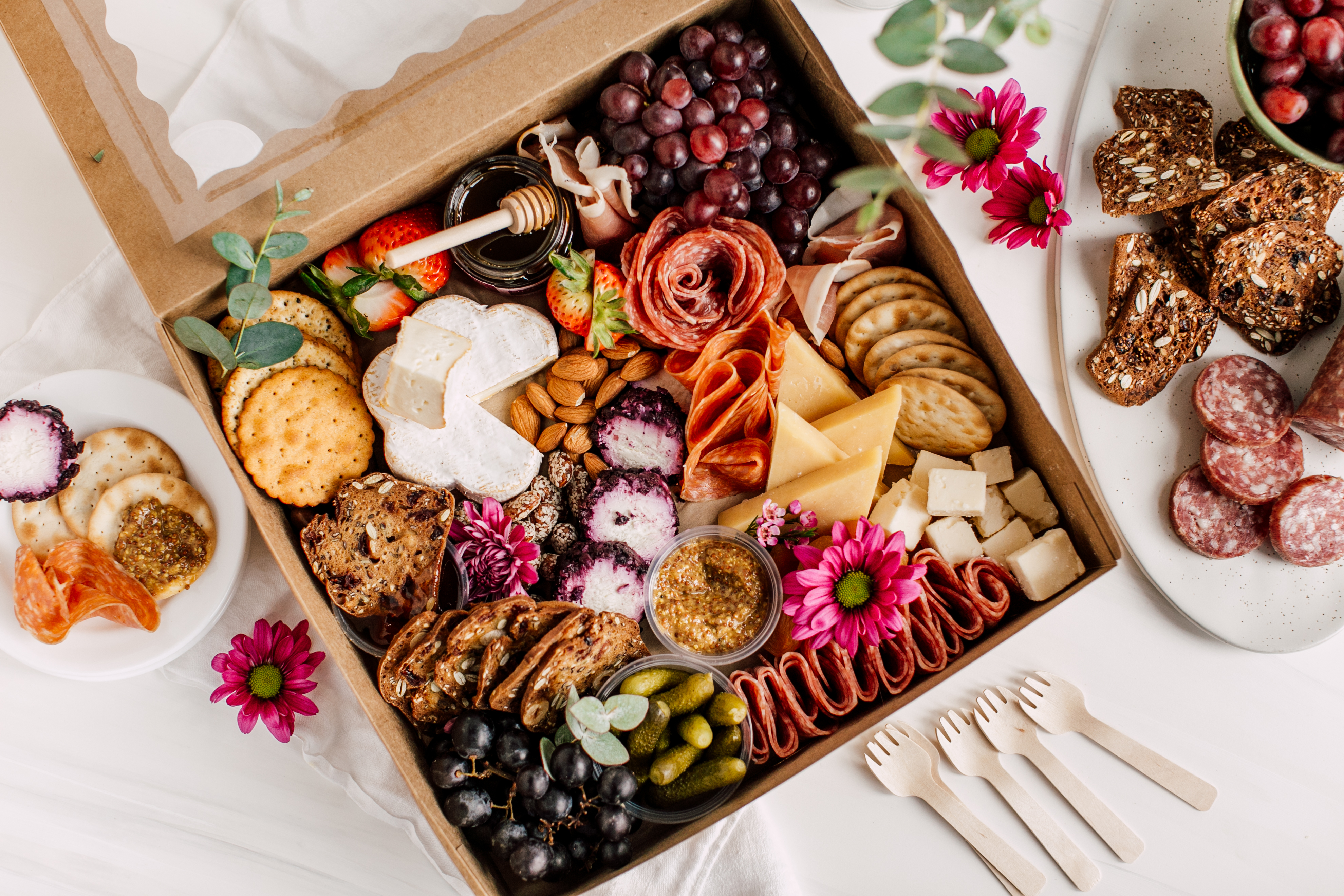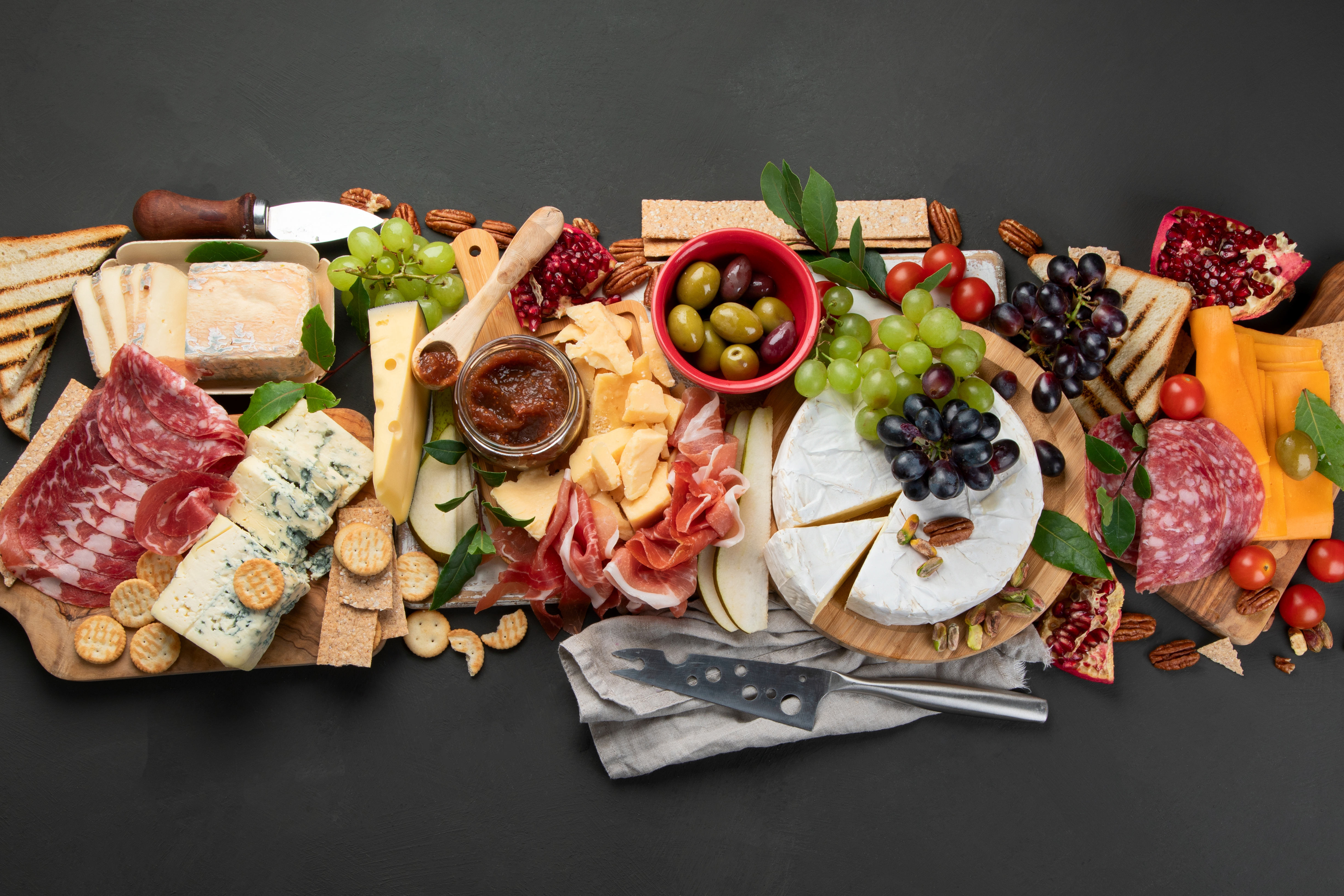Free digital copy
Get Speciality Food magazine delivered to your inbox FREE
Get your free copy
There’s a certain thrill when it comes to curating a charcuterie board. It’s like compiling an edible jigsaw puzzle – all the different elements, from cured meats and cheese, to crackers and chutney, piecing together to form something delicious and visually stunning.
And their popularity and desirability show no signs of abating - a win-win for consumers and retailers. For shoppers, charcuterie boards and grazing platters are an easy and impressive way to wow guests while entertaining at home (something we’re all doing more of), without spending hours slaving away in the kitchen.
While for independent food stores they present the opportunity to really educate and inform people about premium quality cured meats, cheeses and accompaniments, and to suggest and upsell pairings to help customers have the very best epicurean experience.
“I think it’s because we like to share food,” says Paul Patterson, founder of The Charcuterie Box Co in Surrey. “The trend started a while ago, but having sharing boards and putting things in the middle of the table for everyone to pick from communally has been an ever-growing thing. Also, people are going on holidays, maybe to Spain, and having tapas, and wanting to try these things at home. They’re more and more familiar with the salamis and hams, the coppas and bresaola’s, and they’ve got more confidence in them.”
Consumers wanting to make a statement is a factor too. “They’ve gone nuts for charcuterie boards in America”, Paul adds. “The whole thing has become so Instagrammable, with people making swans or roses out of salami, and putting together colourful sharing boards that look so good on a screen. I think they’re a great way to show off your creativity.”

Quality is absolutely key says Paul. Retailers need to pay attention to what they’re buying (noting that shoppers are veering away from overly processed foods) and offer the very best they can at the deli counter. “There’s an awful lot of rubbish out there, and some absolutely terrible processed meats. You don’t need to put a lot of things in to cure meat. It’s essential to choose ethically sourced products – to understand where they’ve come from, and what’s been involved in the curing process.” Retailers and shoppers should be looking for charcuterie produced in a way that showcases the quality of the meat, Paul adds. “If the meat is rubbish it will taste terrible, and if it’s overly processed it’s bad for you!”
After you’ve chosen a reputable supplier, building the best charcuterie board comes down to offering a range of different meats and accompaniments which complement and contrast with each other. “I really like the creative aspect,” adds Paul, “having a range of colours and textures. But you also need to think about introducing some acidity to the whole experience, otherwise it can feel overly indulgent and fatty. Some cornichons, olives, wine, cider or beer. Maybe seasonal berries. Bring in something crunchy too. The whole thing should be a very sensory experience.”
David Nelson of Truffle & Thyme in Wiltshire suggests 80 to 100g of charcuterie per person, and the same for cheese. “This will give you enough for a substantial starter/appetiser/hors d’oeuvres when all of the extra pickles, biscuits, nuts, fresh and dried fruits are added. So far as variety, try and aim to have at least three of each to keep things interesting, with four, or even five being ideal, but it all depends on your budget and how many you’re looking to feed,” he says.
You can arrange cured meats on a board three days in advance, keeping the board well wrapped in film in the fridge. However, any accompaniments (such as crackers, fresh fruit and bread) would pass their peak if included. Ideally prepare the board with everything on it just before serving, or, if that’s not possible, within eight to 12 hours of eating.
Yes. A number of producers make gluten-free charcuterie. For absolute certainty, choose a British maker that you trust. Marsh Pig, The Real Cure and Trealy Farm Charcuterie, for example, all have gluten free products.
This very much depends on the cured meats you are serving, and personal preference of course. If you want to make the charcuterie the star of the show, allowing the nuances of each product to shine through, don’t choose anything too overpowering. A gentle goats’ cheese such as Ribblesdale is a nice option, or any of the buttery, rich, but subtle territorial cheeses, from Double Gloucester, to Cheshire, Creamy Lancashire and Red Leicester – going for a traditional, artisan made variety. Brie and Camembert style cheeses such as Shepherds Purse’s Bluemin White, Fen Farm Dairy’s Baron Bigod, Butlers’ Button Mill, and Caws Cenarth’s Perl Wen work beautifully alongside charcuterie too.
Slate and decorative glass look attractive, but are fragile. For real visual appeal you just can’t beat a wooden board. Wood is naturally antibacterial, and each piece is different, whirled with knots and curves that give every board its own character. Ensure you buy a board made from wood that is food safe (walnut, cherry, oak, maple, olive), considering that hardwood (such as walnut) will be more durable, withstanding sharp knives better than soft grain woods.
Once used, wooden boards are easy to keep clean in good condition for many years to come. Don’t soak them in the sink or put them in the dishwasher, where they’ll split over time, instead give the surface a scrub after using with hot soapy water and a splash of white wine vinegar. Allow to dry completely, and rub in a food grade oil to seal.
Bamboo is another good option. While it’s not wood (bamboo is a grass) it has a similar appearance, and is less porous than many soft woods, making it less likely to absorb stains and smells.

Retailers share their idea of the perfect charcuterie board
Sasha Miles, Howl York: Our dream board contains a lot of the bits our sharing board has. We’d put charcuterie from Curing Rebels on there - their Pirata Loin and Salami Taormina are some of our favourites. We love our Baron Bigod from Fen Farm Dairy, and Cornish Yarg wrapped in wild garlic leaves from Lynher Dairies. We always use the ciabatta from Bluebird Bakery, a local bakery to us. Then we’d finish it off with some cornichons, apple and cider chutney, Gordal olives, sundried tomatoes, and cream cheese-stuffed cherry peppers. Some fresh peaches would go beautifully too.
Toria Smith, Grape & Fig: Our dream combination is quality, British charcuterie (our favourite at the moment is Tempus Spiced Achari) with a dollop of wholegrain mustard, pickles (cornichons and caper berries), and some rosemary nuts. Just perfection!
Mark Gallagher, DukesHill: I’d start with our traditionally made and exceptional-tasting sliced porchetta, bresaola and pastrami. I’d pair those with the best cheese I’ve ever tasted, the award-winning Cheesemaker’s Special Cheese from Alsop & Walker, along with the delicious Hollis Mead Benville Brie and Montagnolo Affiné. Finally, no charcuterie board for me would be complete without our handmade Proper Piccalilli and Apple & Sultana Chutney. And if I’m allowed, I’d include some of our sliced Wiltshire ham. I know it’s not charcuterie, but it’s our famous and most delicious traditionally cured ham.
Paul Patterson, The Charcuterie Box Co: I’d have to include Jamon Iberico and a pata negra, I think…but my dream board would champion British, with Mangalitsa ham, some wild venison fennel salami, and maybe a Wagyu bresaola. I’d have some Baron Bigod Brie on there, and a nice Cheddar from the Isle of Mull, plus cornichons, some borettane balsamic onions, and a few Nocellara olives, washed down with a nice bottle of sparkling wine from the Surrey Hills.
David Nelson, Truffle & Thyme: We either use Spanish or British at Truffle & Thyme. The Spanish are masters at curing meats, and we use a huge amount of Iberico Belotta, salchichon and chorizo from a family-owned Spanish company called Revisan. Being Iberico produced, the pigs are slow grown, acorn fed and outdoor bred. This gives the meat extra fattiness which makes for a much fuller flavour. The standard salchichon has a lovely amount of pepperiness to it, without being overpowering, and the chorizo, whilst the texture is the same as the salchichon, is beautifully smoky and will add another dimension to your grazing. To compliment the sliced meats, we love using Salgot’s mini Fuet; small, bite-sized saucisson, adding that different texture to the charcuterie experience.
Recently, though, we’ve begun using a relatively new English cured meats producer – Bray Cured. Based in Bray, Berkshire (rubbing shoulders with Heston’s Fat Duck and others) they have been winning a number of coveted Great Taste awards for their charcuterie. We’re beginning to use more and more of their coppa, beef bresaola, fennel salami and chorizo, with each one having a very distinctive flavour profile, so they all sit nicely together on a grazing board and without becoming lost.
When it comes to the cheese, we choose to only use British artisan produced. It’s come such a very long way over the years, is highly regarded world-wide and we love supporting the artisan cheese community. An absolute mainstay is Fen Farm Dairy’s Baron Bigod, made in Suffolk. It’s a Brie de Meaux style soft cheese and is unctuous and utterly delicious. They do a truffled version, too – if that’s your thing. The next cheese we love to use is Trethowan Brothers’ Pitchfork Cheddar. It’s deliciously nutty and a bit more refined than other fruity style Cheddars that are out there. We’re also big fans of the Cornish Gouda Co, a Dutch family who moved to Cornwall to produce milk, but then begin turning their hands to making Gouda instead. And boy have they nailed it; we love their mature and extra mature options. Lastly, try and get White Lake Cheese’s ‘Eve’, again from Somerset. It’s a beautifully soft and mild cheese, daintily wrapped in vine leaf and washed in Somerset cider brandy. Importantly, it doesn’t have the goatiness you might expect, so don’t be put off.
Of course, grazing isn’t just about the charcuterie and cheeses. We love to inject a bit of colour, crunch and zing into our boards and this can be achieved very easily. An absolute must, to help cut through the delicious fattiness of those aforementioned big players, is to include pickled veg. The Fine Cheese Co, to our mind, offer the best pickled onions going. They’re sweet and sharp at the same time, and have a little hint of chilli as well. Caper berries, plump Gordal olives, and zingy little cornichons also help clear the palate, and two or three really good chutneyss from our award-winning Wiltshire neighbours, Tracklements, help it all along. Crackers and biscuits go hand-in-hand with grazing, with Peter’s Yard Fig & Spelt sourdough crackers a favourite of our customers, and Miller’s Artisan 3 Fruit or 3 Seed crackers a suitable option as well. Isle of Wight cherry-on-vine tomatoes, blanched asparagus (when in season), or tenderstem broccoli provide a lovely fresh element; fried salted almonds and pistachios give some crunch and saltiness; and a combination of fresh and dried figs, apricots and cherries, and of course grapes, help with some sweetness to round it all off nicely. Remember colour, flavour and texture a-plenty, and you’ll be sure to have your guests oohing and ahhing when they come to visit.